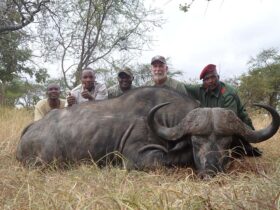
Buffalo Hunting can be done in many areas throughout Africa. They are the most hunted of the Big 5 animals. A buffalo hunt is usually booked as a 10 day package. In Tanzania you can shoot 2 buffalo on your license, other countries limit you to only one buffalo. They are large, difficult to kill, and will confront their pursuer under some circumstances. Some people claim it to be the most dangerous animal to hunt, but I do not agree. I believe that more hunters are killed and wounded by buffalo due to the fact that there are more buffalo hunted and subsequently wounded, thus leading to more dangerous encounters. Buffalo hunting is a close affair on foot that will get anyone’s adrenaline pumping. Fresh tracks are followed on foot for as long as it takes (usually 2-6 hours).
Buffalo typically bed down in the middle of the day and if everything is right we can sneak in on the herd and select a good bull. If things continue to go our way, you will usually shoot this large animal at 50 yards or closer. After the shot it will most likely run into the brush with the others. If it is hit is good, the wounded bull will not be able to keep up with the herd and will peel off from the group, thus making tracking easier. Sometimes, we find him dead, sometimes he waiting for us, and sometimes running away. Backup shots are often required when hunting buffalo. Bigger is better when it comes to guns for buffalo (.375 or larger). I recommend using high quality soft points (Swift A-Frame or Barnes) followed by solid bullets.
Your PH should load with solids and is there to back you up if necessary. Buffalo seem to have a super natural ability to absorb large amounts of lead. If you’re into excitement and adrenaline you will find buffalo hunting an addictive sport.
General Buffalo Information
- Habitat: Their primary habitat requirements are a plentiful supply of grass, shade and water. Buffalo are primarily grazers, and like to drink twice a day: they often wade into the water up to their bellies when drinking. They therefore occur in the better-watered northern and eastern parts of the southern African sub region, and avoid arid areas. They do not frequent wide open grasslands that are far from the shade they require for resting up in during the heat of the day, although they do move seasonally and may cross large, open expanses. They often graze in the vicinity of water, resting in the vicinity of reed beds. The bulls often wallow in mud, which not only helps keep them cool, but is good for their skin and helps control biting insects.
- Habits: Buffalo are gregarious, occurring in herds of up to several thousand individuals. These herds are relatively stable associations, with the smaller herds forming into larger ones temporarily. Buffalo herds move seasonally in search of adequate grazing and water. There may be family cohesion of females within the herd: family ties in the males do not last beyond three years of age. Old and young bulls may leave the herd and form small bachelor herds, but the two age classes are usually found apart. There is an established hierarchy; both within bachelor herds and large herds, and old bulls often get harassed, which can result in them becoming solitary. The linear hierarchy is maintained primarily by threat behavior rather than by serious fighting (see communication), although if this doesn’t prove a deterrent then fighting will occur. Fighting consists of the opponents charging each other and growling, then lowering their heads to take the impact on their horns. Due to their small size, bachelor herds can exploit small food niches such as occur along lake shores, whereas large herds need to have very large home ranges. Herds tend to move to water in the early morning and late afternoon.
Buffalo are inquisitive, and will often approach vehicles to examine them. If a herd is disturbed the individual buffalo will often stampede in unexpected directions. They are considered one of the most dangerous of the African species to hunt, and wounded buffalo have been known to double back and ambush their attackers.- Feeding and Diet: Buffalo have the most efficient digestive system for digesting fibrous food of any of the ruminants. While they will feed on fresh, new grass such as occurs in freshly burnt areas, they also readily eat old grass, and can adequately cope with digesting it. Their habit of eating old grass and trampling it helps to open up these areas to other species by enabling new growth on them. During the rainy season, when food is abundant, they become selective feeders, and prefer red grass, buffalo grass, small buffalo grass, and finger grasses. Buffalo are sensitive to heat, and move into the shade during the heat of the day. Much of their feeding takes place at night, and they spend a large proportion of their time ruminating, especially during the dry season when the grass has a higher fiber content.
Their mouth parts are adapted for feeding on long grass, as they pull the grass into their mouths using their tongues, and bite stalks off by moving their lower incisors against the dental pad in their lower jaw.
Communication: Much of the communication is in the form of body language: the hierarchy between males is maintained by threatening displays with the head held high, nose pointing to the ground, or by both of these: the body is held laterally to emphasize its size.- Reproduction: While most male buffalo reach sexual maturity between 3.5 and 5.5 years old, they are not usually allowed to breed until they are 8 – 10 years old. Females, however, can have their first calf when they are 4 – 5 years old. Most buffalo calves are born in the summer months, and usually either during the late afternoon or just before dawn, when the herd is resting. A single calf is born, and new-born calves can follow the herd a few hours after birth: if the herd moves during this time the mother and calf may be left behind temporarily. Calves are sometimes hidden in thick undergrowth while the mother grazes nearby. The bond between mother and calf is fairly strong, and they communicate via croaking calls from the mother and bleating by the calf. Calves continue to suckle until they are about 15 months old, and can remain with their mother until the age of 2. Calf mortality is fairly high, as they are targeted by predators.







































































